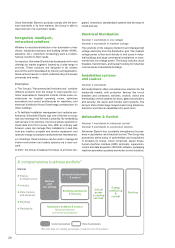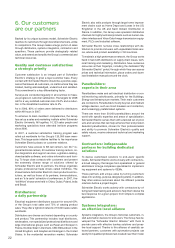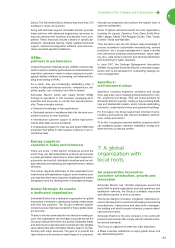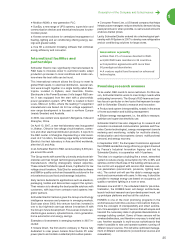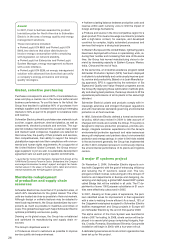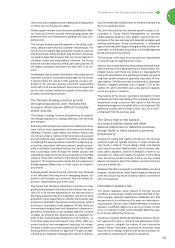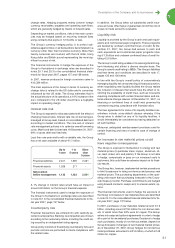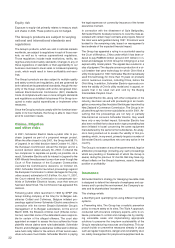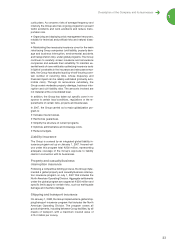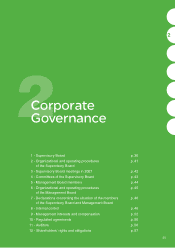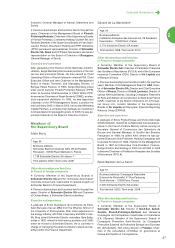APC 2007 Annual Report Download - page 31
Download and view the complete annual report
Please find page 31 of the 2007 APC annual report below. You can navigate through the pages in the report by either clicking on the pages listed below, or by using the keyword search tool below to find specific information within the annual report.
29
Description of the Company and its businesses
1
ing Committee that initially meets at monthly intervals and
then on a quarterly basis.
The unit that presents the external growth project is ac-
countable to Group Senior Management for meeting
clearly-defined business plan targets covering the per-
formance of the new business and expected synergies with
existing businesses. Actual performance is measured
against business plan targets during quarterly business re-
views and, for the largest acquisitions, by the Management
Board and Supervisory Board.
The follow-up of the value of the acquisitions implemented
is done through annual impairment tests.
Value in use is determined by discounting estimated future
cash flows that will be generated by the tested assets. Es-
timated future cash flows are based on management’s
economic assumptions and operating forecasts, as well as
long-term growth prospects generally equivalent to fore-
cast inflation. The discount rate corresponds to Schneider
Electric's weighted average cost of capital (7.5% at De-
cember 31, 2007 and 2006), plus a risk premium depend-
ing on the region in question.
The majority of the Group's goodwill is allocated to CGUs
in Europe and the United States. This goodwill is tested for
impairment using a discount rate equal to the Group's
weighted average cost of capital, with no risk premium. The
perpetuity growth rate for these CGUs was 2% in 2007,
unchanged from the previous year.
The Group may be the subject
of product liability claims and other
adverse effects due to defective products,
design faults or harm caused to persons
and property
Despite its testing and quality procedures, the Group’s
products might not operate properly or might contain de-
sign faults or defects. These design faults and defects
could result in product liability claims, loss of revenue, war-
ranty claims, litigation, a fall-off in demand or harm to our
reputation for safety and quality. To prevent or limit these
risks, the Group recalls products if there are any doubts
about a component, even if the defect is random and does
not pose a safety risk.
Schneider Electric is covered by a global liability insurance
program. Insured values under these programs adequately
cover the Group's exposure to liability claims in connection
with its businesses.
Information systems risk
The Group operates, either directly or through service
providers, a wide range of highly complex information sys-
tems (servers, networks, applications, databases, etc.) that
are essential to the efficiency of its sales and manufactur-
ing processes. Failure of any of these hardware or software
systems, a fulfillment failure by a service provider, human
error or computer viruses could adversely affect the qual-
ity of service offered by the Group.
The Group regularly examines alternative solutions to pro-
tect against this type of risk and has developed contin-
gency plans to mitigate the effects of any information
system failure. Dedicated governance structures have
been set up to manage relations with service providers re-
sponsible for outsourced IT systems operations.
other technical competencies by creating technology parks
in China, the US, France and Japan.
Global support centers have also been established in Mex-
ico, India and China to provide the technology parks with
additional skills and development capacity at a very com-
petitive cost.
The Group’s business growth depends on its ability to de-
velop, deepen and enhance customer relationships. The
Group must constantly offer customers innovative solutions
built around high quality products and services incorporat-
ing leading-edge technologies that are closely tailored to
customer needs and expectations. However, the Group
does not have any exposure with a particular customer. Its
ten largest customers represent less than 25% of its rev-
enue.
Increasingly high customer satisfaction rates represent an
important source of competitive advantage for the Group.
It closely tracks the results of the quarterly surveys con-
ducted in 55 countries among customers representing
some 96% of its annual revenue. Improvement targets are
set for each country, backed by specific action plans and
progress monitoring procedures.
The Group’s strategy involves growth
through acquisitions, joint ventures and
mergers, which may be difficult to identify
and/or execute
The Group’s strategy involves strengthening its capabili-
ties through acquisitions, strategic alliances, joint ventures
and mergers.
External growth projects are examined in detail by the busi-
ness units, country organizations and corporate functions
(Strategy, Finance, Legal Affairs and Human Resources)
concerned under a rigorous internal process developed
and led at Group level. A launch committee is responsible
for initiating the review process to identify the risks and op-
portunities associated with each external growth project,
while a validation committee reviews the results. Projects
that successfully come through the review process are
submitted for approval to the Group acquisitions committee
made up of the main members of the Group’s Senior Man-
agement. The largest projects require the prior approval of
the Management Board and, in some cases, the Supervi-
sory Board.
External growth transactions are inherently risky because
of the difficulties that may arise in integrating people, op-
erations, technologies and products, and the related ac-
quisition, administrative and other costs.
The Group has therefore developed a process for inte-
grating newly-acquired businesses that extends over a pe-
riod of 6 to 24 months depending on the type and size of
the newly acquired entity. The integration scenario for each
acquisition varies depending on whether the business was
acquired to strengthen the Group's existing lineup, extend
the lineup or penetrate a new segment. All told, there are
five scenarios ranging from total integration to separate or-
ganization. Depending on the strategic objective, a matrix
is drawn up showing the required level of integration for
each of the newly-acquired business's core functions, i.e.
front office (sales force and brand), back office, R&D, cor-
porate functions and management reporting. An integra-
tion plan is drawn up for each acquisition and submitted to
the acquisitions committee for approval. The plan is imple-
mented by an integration manager who reports to a Steer-



